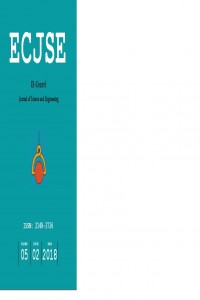Öz
Bu çalışmada STEM SOS modelinin öğrencilerin farklı
değişkenler üzerine etkilerinin neler olduğu
araştırılmıştır. Çalışma 2016-2017 eğitim öğretim yılı bahar yarı
yılında 10. Sınıfta öğrenim görmekte olan 21 lise öğrencisi ile
gerçekleştirilmiştir. Çalışma kapsamında veri toplama aracı olarak araştırmacı
tarafından geliştirilen “STEM SOS yarı yapılandırılmış görüşme formu”
kullanılmıştır. Çalışma kapsamında nitel veriler bu görüşme formu sonucunda
elde edilmiştir. Elde edilen nitel veriler içerik analizine tabi tutulmuştur.
İçerik analizi sonucunda, öğrencilerin STEM SOS modeline uygun olarak
hazırlanan projeleri faydalı bulduğu, bu projelerin birçok faydasının olduğu
sonucuna ulaşılmıştır. Öğrencilerin hazırladıkları projeleri sunmaları
sırasında ise heyecanlandıkları, mutlu oldukları ve onu duydukları gibi birçok
özelliğinde kazanılmasına katkı sağladığı görülmektedir. Ayrıca STEM SOS
modeline uygun hazırlanmış projelerin Level I ve II düzeylerinde yoğunlaştığı
görülürken sadece bir projenin Level III düzeyinde olduğu tespit edilmiştir.
Elde edilen bu sonuçlar neticesinde yeni yapılacak olan araştırmalar için
önerilerde bulunulmuştur.
Anahtar Kelimeler
Kaynakça
- [1] Bybee, R. W. (2010). What is STEM education. Science, 329, 996. doi: 10.1126/science.1194998.
- [2] Morrison, J. (2006). Attributes of STEM education: The student, the school, the classroom. TIES (Teaching Institute for Excellence in STEM). Erişim 28 Mayıs 2017 tarihinde: http://www.wytheexcellence.org/media/STEM_Articles.pdf.
- [3] Gonzalez, H. B. & Kuenzi, J. J. (2012). science, technology, engineering and mathematics (STEM) education: A Primer. Congressional Research Service. https://www.fas.org/sgp/crs/misc/R42642.pdf sayfasından erilişmiştir.
- [4] Gülgün, C., Yılmaz, A. ve Çağlar, A. (2017). “Teacher opinions about the qualities required in STEM activities applied in the science course.”, Journal of Current Researches on Social Sciences, 7(1), 459-478.
- [5] Milli Eğitim Bakanlığı. (2016). STEM eğitim raporu. Ankara: Yenilik ve Eğitim Teknolojileri Genel Müdürlüğü.
- [6] American Institute of Physics. (2015). President Obama on STEM education. https://www.aip.org/fyi/2015/president-obama-stem-education sayfasından 10 Mayıs 2017 tarihinde erişilmiştir.
- [7] Banks, F., ve Barlex, D. (2014). Teaching STEM in the secondary school: How teachers and schools can meet the challenge. London: Routledge.
- [8] Dugger, W. E. (2010, December). Evolution of STEM in the united states. the 6th Biennial International Conference on Technology Education Research‟nda sunulmuş bildiri, Gold Coast, Queensland, Australia.
- [9] Thomas, T.A. (2014). Elementary teachers’ receptivity to integrated science, technology, engineering, and mathematics (STEM) education in the elementary grades. Doctoral dissertation, University of Nevada, Reno.
- [10] Yıldırım, B., (2016). 7. Sınıf fen bilimleri dersine entegre edilmiş fen teknoloji mühendislik matematik (STEM) uygulamaları ve tam öğrenmenin etkilerinin incelenmesi. Doktora Tezi, Gazi Üniversitesi, Eğitim Bilimleri Enstitüsü, Ankara.
- [11] Childress, V. W. (1996). Does integration technology, science, and mathematics improve technological problem solving: A quasi-experiment. Journal of Technology Education, 8(1), 16–26.
- [12] Cotabish, A., Dailey, D. Robinson, A. ve Hunghes, G., (2013). The Effects of a STEM intervention on elementary students' science knowledge and skills. School Science and Mathematics, 113(5), 215-226.
- [13] Elliott, B., Oty, K., McArthur, J., ve Clark, B. (2001). “The effect of an interdisciplinary algebra/science course on students‟ problem solving skills, critical thinking skills and attitudes towards mathematics.” International Journal of Mathematical Education in Science and Technology, 32(6), 811–816.
- [14] Yıldırım, B. ve Selvi M. (2017). STEM uygulamaları ve tam öğrenmenin etkileri üzerine deneysel bir çalışma. Eğitimde Kuram ve Uygulama, 13 (2), 183-210.
- [15] Capraro, R. M., Capraro, M. M. ve Morgan, J. (Eds.). (2013). Project-based learning: an integrated science, technology, engineering, and mathematics (STEM) approach (2nd ed.). Rotterdam: Sense.
- [16] Han, S., Capraro, R., ve Capraro, M.M. (2015). “How Science, Technology, Engineering, and Mathematics (STEM) Project-Based Learning (PBL) Affects High, Middle, and Low Achievers Differently: The Impact of Student Factors on Achievement.” International Journal of Science and Mathematics Education, 3(5), 1089-1113.
- [17] Sahin, A., ve Top, N., (2015). “STEM students on the stage (SOS): promoting student voice and choice in stem education through an ınterdisciplinary, standards-focused, project based learning approach.” Journal of STEM Education, 16(3), 24-31.
- [18] Sahin, A. (Ed.). (2015). A Practice-based Model of STEM Teaching: STEM Students on the Stage (SOS). Sense Publishers, Rotterdam.
- [19] Selvi, M. & Yıldırım, B. (2017). STEM öğretme-öğrenme modelleri: 5e öğrenme modeli, proje tabanlı öğrenme ve STEM SOS modeli. S. Çepni (Ed.). Kuramdan Uygulamaya STEM+A+E Eğitimi (s.203-236). Ankara: Pegem.
- [20] Creswell, J.W. (2003). Research design: Qualitative, quantitative, and mixed methods approaches. Thousand Oaks, CA: Sage.
- [21] Glesne, C. (2014). Nitel araştırmaya giriş (A. Ersoy & P. Yalçınoğlu, Çev.). Ankara: Anı Yayıncılık.
- [22] Laboy-Rush, D. (2011). Integrated STEM education through Project-Based Learning. Retrieved from http://springdale.sharpschool.net/UserFiles/Servers/Server_2942959/File/Departments/InstructionalPlan/Integrated%20STEM%20Education%20through%20Project-Based%20Learning.pdf
- [23] Meyrick, K. M., (2011). How STEM education improve student learning. Meridian K-12 School Computer Technologies Journal, 14(1), 1-6.
- [24] Larsen, A. (2016). Project-Based Learning’s Effect on Students’ Understanding and Usage of the Engineering Design Process. (Unpublished doctoral thesis), Saint Catherine University, Minnesota.
- [25] Craft, A.M., Capraro, R.M. (2017). Science, technology, engineering, and mathematics project-based learning: merging rigor and relevance to ıncrease student engagement. Electronic International Journal of Education, Arts, and Science, 3(6), 140-158.
- [26] Hasni, A., Bousadra, F., Belletete, V., Benabdallah, A., Nicole, M., Dumais, N., “Trends in research on project-based science and technology teaching and learning at K-12 levels: A systematic review.” Studies in Science Education, 2012, 52(2), 199-231.
- [27] Tseng, K., Chang, C., Lou, S. & Chen, W. (2013). Attitudes towards science, technology, engineering and mathematics (STEM) in a project-based learning environment. International Journal of Technology and Design Education, 23(1), 87-102.
Ayrıntılar
| Birincil Dil | Türkçe |
|---|---|
| Konular | Mühendislik |
| Bölüm | Makaleler |
| Yazarlar | |
| Yayımlanma Tarihi | 31 Mayıs 2018 |
| Gönderilme Tarihi | 9 Ocak 2018 |
| Kabul Tarihi | 8 Şubat 2018 |
| Yayımlandığı Sayı | Yıl 2018 Cilt: 5 Sayı: 2 |



